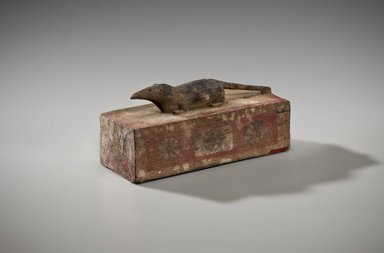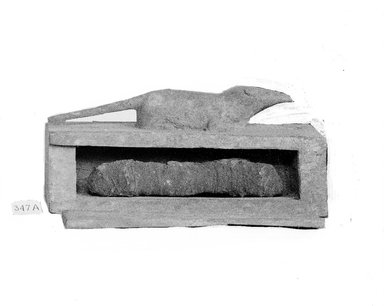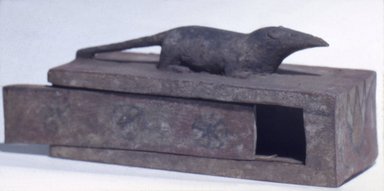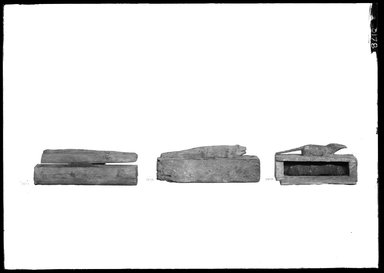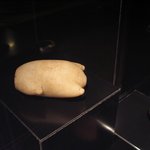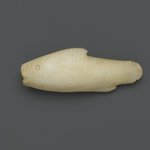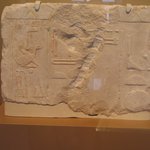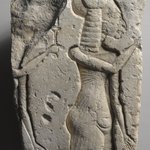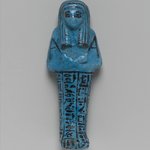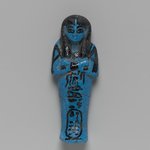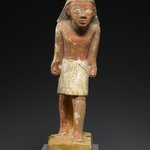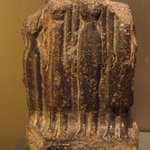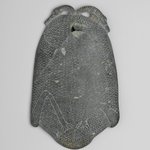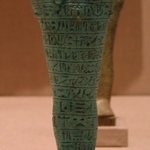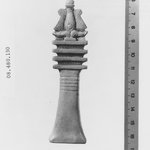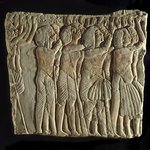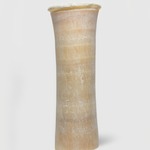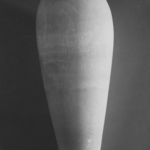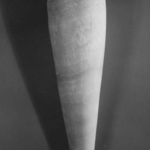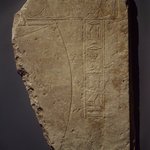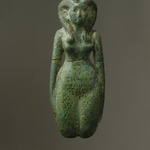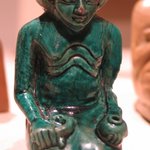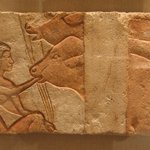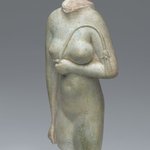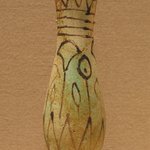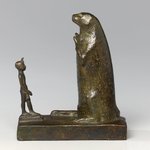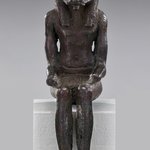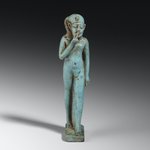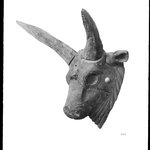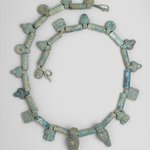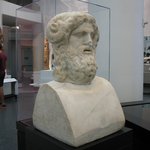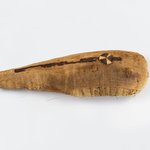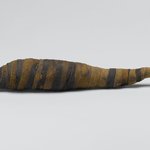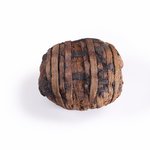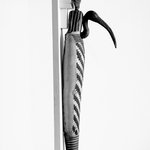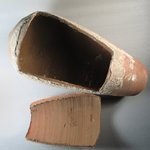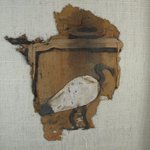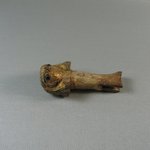Shrew Coffin with Mummy
Egyptian, Classical, Ancient Near Eastern Art
Shrews and ichneumons both prey on snakes and therefore won the Egyptians’ admiration and worship. Though snakes could turn their powers to protecting kings and queens, serpents also threatened the sun god Re on his journey through the next world. Egyptian religion made room for both the positive and negative aspects of certain animals.
The shrew mummy bundle shows that more than one animal was sometimes included in one package.
MEDIUM
Wood, pigment, animal remains, linen
DATES
664–332 B.C.E.
DYNASTY
Dynasty 26, or later
PERIOD
Late Period, or later
DIMENSIONS
37.1362Ea (Coffin): 3 1/16 x 2 13/16 x 6 13/16 in. (7.7 x 7.1 x 17.3 cm)
37.1362Eb (Panel): 3 1/2 x 15 1/2 x 11/16 in. (8.9 x 39.4 x 1.8 cm)
37.1362Ec (Mummy): 1 x 1 x 4 13/16 in. (2.6 x 2.6 x 12.3 cm)
(show scale)
ACCESSION NUMBER
37.1362Ea-c
CREDIT LINE
Charles Edwin Wilbour Fund
CATALOGUE DESCRIPTION
One wooden coffin for a shrew mouse. The coffin (37.1362Ea) is roughly rectangular in shape with a sliding wooden panel on the side (37.1362Eb), which opens to allow access to the interior. Atop the coffin a representation of a shrew mouse had been carved. This is one piece with the coffin. Eyes, ears, feet, and tail as well as the snout are realistically rendered. The coffin was painted in a very colorful manner. The sliding panel being decorated with three circles. The end panels are painted with a lotus blossom and are circle design like that of the panel, respectively. A red border has been painted around the top side. The colors employed are red, black, and white. No gesso was used. A mummy is contained within (37.1362Ec).
Condition: The paint is slowly disappearing. Much is lost from the sliding panel and the end panels, especially that bearing the circle motif. The other end panel had fared better. Some superficial cracks exist.
MUSEUM LOCATION
This item is not on view
CAPTION
Shrew Coffin with Mummy, 664–332 B.C.E. Wood, pigment, animal remains, linen, 37.1362Ea (Coffin): 3 1/16 x 2 13/16 x 6 13/16 in. (7.7 x 7.1 x 17.3 cm). Brooklyn Museum, Charles Edwin Wilbour Fund, 37.1362Ea-c. Creative Commons-BY (Photo: Brooklyn Museum (Gavin Ashworth,er), 37.1362Ea-b_Gavin_Ashworth_photograph.jpg)
IMAGE
overall, 37.1362Ea-b_Gavin_Ashworth_photograph.jpg. Brooklyn Museum photograph (Gavin Ashworth, photographer), 2012
"CUR" at the beginning of an image file name means that the image was created by a curatorial staff member. These study images may be digital point-and-shoot photographs, when we don\'t yet have high-quality studio photography, or they may be scans of older negatives, slides, or photographic prints, providing historical documentation of the object.
RIGHTS STATEMENT
Creative Commons-BY
You may download and use Brooklyn Museum images of this three-dimensional work in accordance with a
Creative Commons license. Fair use, as understood under the United States Copyright Act, may also apply.
Please include caption information from this page and credit the Brooklyn Museum. If you need a high resolution file, please fill out our online
application form (charges apply).
For further information about copyright, we recommend resources at the
United States Library of Congress,
Cornell University,
Copyright and Cultural Institutions: Guidelines for U.S. Libraries, Archives, and Museums, and
Copyright Watch.
For more information about the Museum's rights project, including how rights types are assigned, please see our
blog posts on copyright.
If you have any information regarding this work and rights to it, please contact
copyright@brooklynmuseum.org.
RECORD COMPLETENESS
Not every record you will find here is complete. More information is available for some works than for others, and some entries have been updated more recently. Records are frequently reviewed and revised, and
we welcome any additional information you might have.
What Egyptian god is the shrew is supposed to be associated with?
Shrews were used to stand in for the ichneumon, the African mongoose. The ichneumon was associated with Horus and the god Atum, and was worshipped for it's ability to see in the dark and ability to kill snakes.
You might have seen a small statue of a king and (much larger) Ichneumon elsewhere in the exhibition!
Interesting! I knew the ichneumon was variously worshipped, also as the goddess Mafdet, but I didn't know the shrew could be a possible stand-in for it.
Isn't it fascinating?
It really is!
Tell me more.

This is a wooden coffin with a shrew figurine on top. Shrews
were associated with the sun god. Because of their night vision and talent at killing snakes , they aided the sun god in his battle against the evil serpent Apep, who threatened to throw the world into disorder.
